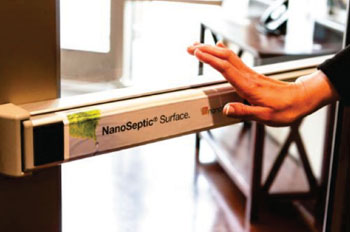NanoSeptic Surface Effective Against a Variety of Pathogens
|
By HospiMedica International staff writers Posted on 02 Apr 2014 |

Image: A door handle coated with a NanoSeptic Surface (Photo courtesy of NanoTouch Materials).
An innovative disruptive technology provides a new tool in the fight against infection and illness of even the most dangerous pathogens.
The NanoSeptic surface, developed in the Center for Advanced Engineering and Research (CAER; Forest, VA, USA) and manufactured by NanoTouch Materials (Forest, VA, USA), is composed of antimicrobial components that are molecularly bonded on a nanoscale, providing a nonleaching, self-cleaning surface that constantly traps and kills bacteria, viruses, and fungi through a catalytic oxidation process using available light. The surfaces also eventually degrade the endotoxins the are the result of bacterial death.
The surfaces work constantly kill pathogens utilizing nanotechnology rather than chemicals, diluted poisons, or heavy metals, and for a period that lasts 6-12 months, as long as he surface is not worn. Possible applications and targets include facility touch points such as door push-pads and handle wraps, as well as portable mats for counters, tray tables, and bathroom vanities. The surfaces were tested at King Abdul-Aziz University Hospital (KSU; Riyadh, Saudi Arabia) against several types of Gram positive, Gram negative, and Methicillin-resistant Staphylococcus aureus (MRSA) bacteria.
“After receiving the initial test results, we started calling the NanoSeptic products 'Magical Paper' because of their ability to kill bacteria,” said Amr Saeb, PhD, head of biotechnology at KSU. “This product was able to Kill 100% of E. coli and P. aeruginosa and 88% of MRSA germs after only one hour. As a microbial geneticist, I am really excited by the latest approaches to kill pathogens in a safe and environmentally conscious way without generating resistant microbes which are difficult to treat.”
“At NanoTouch, we're so excited that research centers across the globe are validating our ongoing mission—to change the world.” said Dennis Hackemeyer, cofounder of NanoTouch Materials. “Another exciting aspect of NanoSeptic products is the visual communication which has the potential to change behavior. Visitors gravitate toward touching the NanoSeptic surface which keeps other surfaces cleaner.”
Related Links:
Center for Advanced Engineering and Research
NanoTouch Materials
The NanoSeptic surface, developed in the Center for Advanced Engineering and Research (CAER; Forest, VA, USA) and manufactured by NanoTouch Materials (Forest, VA, USA), is composed of antimicrobial components that are molecularly bonded on a nanoscale, providing a nonleaching, self-cleaning surface that constantly traps and kills bacteria, viruses, and fungi through a catalytic oxidation process using available light. The surfaces also eventually degrade the endotoxins the are the result of bacterial death.
The surfaces work constantly kill pathogens utilizing nanotechnology rather than chemicals, diluted poisons, or heavy metals, and for a period that lasts 6-12 months, as long as he surface is not worn. Possible applications and targets include facility touch points such as door push-pads and handle wraps, as well as portable mats for counters, tray tables, and bathroom vanities. The surfaces were tested at King Abdul-Aziz University Hospital (KSU; Riyadh, Saudi Arabia) against several types of Gram positive, Gram negative, and Methicillin-resistant Staphylococcus aureus (MRSA) bacteria.
“After receiving the initial test results, we started calling the NanoSeptic products 'Magical Paper' because of their ability to kill bacteria,” said Amr Saeb, PhD, head of biotechnology at KSU. “This product was able to Kill 100% of E. coli and P. aeruginosa and 88% of MRSA germs after only one hour. As a microbial geneticist, I am really excited by the latest approaches to kill pathogens in a safe and environmentally conscious way without generating resistant microbes which are difficult to treat.”
“At NanoTouch, we're so excited that research centers across the globe are validating our ongoing mission—to change the world.” said Dennis Hackemeyer, cofounder of NanoTouch Materials. “Another exciting aspect of NanoSeptic products is the visual communication which has the potential to change behavior. Visitors gravitate toward touching the NanoSeptic surface which keeps other surfaces cleaner.”
Related Links:
Center for Advanced Engineering and Research
NanoTouch Materials
Latest Critical Care News
- Bioadhesive Strategy Prevents Fibrosis Around Device Implants on Peripheral Nerves
- Miniature Non-Invasive Robotic Catheters to Improve Infertility Treatments
- Stick-On Patch Monitors Baby's Movements In Utero
- EEG-Based AI Technology Accurately Diagnoses Alzheimer’s and Dementia
- Robot Lymphatic System Paves Way for Self-Powered Wearables and Machines
- Focused Ultrasound Technique Successfully Treats Pediatric Brain Cancer
- Nasal Drops Fight Brain Tumors Noninvasively
- AI Helps Optimize Therapy Selection and Dosing for Septic Shock
- Glowing Bacteria ‘Pills’ for Detecting Gut Diseases Could Eliminate Colonoscopies
- Skin-Permeable Polymer Patch Delivers Insulin Non-Invasively Through Skin
- Nanogel Technology Almost 100% Effective in Destroying Drug-Resistant Bacteria Within Hours
- Wearable Ultrasound Sensor Delivers Noninvasive Treatment Without Surgery
- Gel-Free ECG System to Transform Heart Health Diagnosis
- Biodegradable Patch Repairs Damaged Tissue After Heart Attack
- Magnetically Guided Microrobots to Enable Targeted Drug Delivery

- Smart Nanomaterials Detect and Treat Traumatic Brain Injuries Simultaneously
Channels
Surgical Techniques
view channel
Catheter-Based Procedures Offer Less Invasive Option for Treatment of Valvular Disease
Valvular heart disease, caused by tight or leaky valves between heart chambers, affects up to 10% of older adults and leads to more than 120,000 deaths globally each year. Traditional open-heart surgery... Read moreLaparoscopic Surgery Improves Outcomes for Severe Newborn Liver Disease
Biliary atresia is a rare but life-threatening liver condition in newborns that blocks bile flow and leads to progressive liver damage if not treated early. Surgery is typically performed within the first... Read morePatient Care
view channel
Revolutionary Automatic IV-Line Flushing Device to Enhance Infusion Care
More than 80% of in-hospital patients receive intravenous (IV) therapy. Every dose of IV medicine delivered in a small volume (<250 mL) infusion bag should be followed by subsequent flushing to ensure... Read more
VR Training Tool Combats Contamination of Portable Medical Equipment
Healthcare-associated infections (HAIs) impact one in every 31 patients, cause nearly 100,000 deaths each year, and cost USD 28.4 billion in direct medical expenses. Notably, up to 75% of these infections... Read more
Portable Biosensor Platform to Reduce Hospital-Acquired Infections
Approximately 4 million patients in the European Union acquire healthcare-associated infections (HAIs) or nosocomial infections each year, with around 37,000 deaths directly resulting from these infections,... Read moreFirst-Of-Its-Kind Portable Germicidal Light Technology Disinfects High-Touch Clinical Surfaces in Seconds
Reducing healthcare-acquired infections (HAIs) remains a pressing issue within global healthcare systems. In the United States alone, 1.7 million patients contract HAIs annually, leading to approximately... Read moreHealth IT
view channel
EMR-Based Tool Predicts Graft Failure After Kidney Transplant
Kidney transplantation offers patients with end-stage kidney disease longer survival and better quality of life than dialysis, yet graft failure remains a major challenge. Although a successful transplant... Read more
Printable Molecule-Selective Nanoparticles Enable Mass Production of Wearable Biosensors
The future of medicine is likely to focus on the personalization of healthcare—understanding exactly what an individual requires and delivering the appropriate combination of nutrients, metabolites, and... Read moreBusiness
view channel
Philips and Masimo Partner to Advance Patient Monitoring Measurement Technologies
Royal Philips (Amsterdam, Netherlands) and Masimo (Irvine, California, USA) have renewed their multi-year strategic collaboration, combining Philips’ expertise in patient monitoring with Masimo’s noninvasive... Read more
B. Braun Acquires Digital Microsurgery Company True Digital Surgery
The high-end microsurgery market in neurosurgery, spine, and ENT is undergoing a significant transformation. Traditional analog microscopes are giving way to digital exoscopes, which provide improved visualization,... Read more
CMEF 2025 to Promote Holistic and High-Quality Development of Medical and Health Industry
The 92nd China International Medical Equipment Fair (CMEF 2025) Autumn Exhibition is scheduled to be held from September 26 to 29 at the China Import and Export Fair Complex (Canton Fair Complex) in Guangzhou.... Read more














